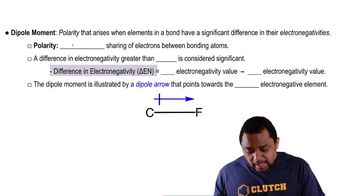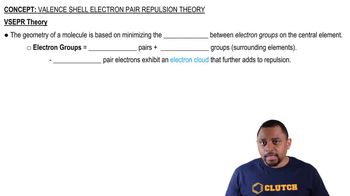Here are the essential concepts you must grasp in order to answer the question correctly.
Molecular Geometry
Molecular geometry refers to the three-dimensional arrangement of atoms within a molecule. It is determined by the number of bonding pairs and lone pairs of electrons around the central atom, which influences the shape of the molecule. For PCl3, the geometry is trigonal pyramidal due to one lone pair, while PCl5 has a trigonal bipyramidal shape with no lone pairs.
Recommended video:
Molecular Geometry with Two Electron Groups
Polarity and Dipole Moment
Polarity in molecules arises from differences in electronegativity between bonded atoms, leading to uneven distribution of electron density. A dipole moment is a vector quantity that measures the separation of positive and negative charges in a molecule. PCl3 has a net dipole moment due to its asymmetrical shape, while PCl5 is symmetrical, resulting in no overall dipole moment.
Recommended video:
Valence Shell Electron Pair Repulsion (VSEPR) Theory
VSEPR theory is a model used to predict the geometry of molecules based on the repulsion between electron pairs in the valence shell of the central atom. According to this theory, electron pairs will arrange themselves to minimize repulsion, leading to specific molecular shapes. This theory helps explain the different geometries of PCl3 and PCl5 and their resulting polarities.
Recommended video:
Valence Shell Electron Pair Repulsion Theory
 Verified step by step guidance
Verified step by step guidance


